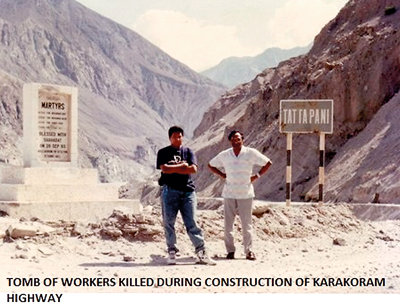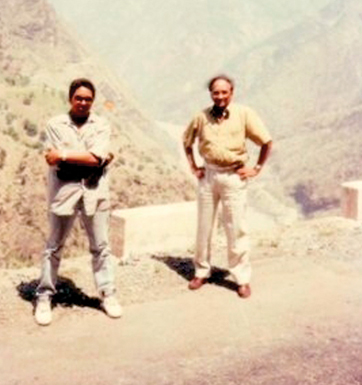The high road to Shangri-la
The Karakoram Highway (KKH) is a friendship highway built jointly by China and Pakistan between Kashgar (China) and Abbottabad in Pakistan. Almost 1300 km long, parts of the road have been built on the ancient Silk Route. Work on the highway began in 1959 and was completed in 1986.

The construction of this road involved work in difficult terrain and over 800 Pakistani and 200 Chinese workmen died in accidents during construction. The graves and memorials to these workmen lie at regular intervals along the KKH.
The highest paved road in the world, the KKH passes through breathtaking, sometimes terrifying scenery, through the most beautiful parts of Northern Pakistan with views of some of the highest mountains in the Himalayan range. It has also been referred to as the ninth wonder of the world. The Khunjerab Pass, 15,397 ft above sea level is said to be the meeting place of the Hindu Kush, the Himalayas and the Karakoram ranges.
An article written in the local papers many years ago by the wife of an Ambassador to Sri Lanka remained etched in my mind and I was determined that should the opportunity present itself, this was a trip I had to make.
In 1991 I arranged the trip with a Pakistani travel agent and accompanied by my wife and children, started off from Lahore. There were no problems, political or otherwise, in Pakistan at that time and most of the time we drove through country very much like the drier parts of Sri Lanka. But as we went further on the KKH, the terrain became spectacular.
In Islamabad we visited the beautiful King Faisal Mosque, a gift by King Faisal to the people of Pakistan designed by renowned Muslim architects drawn from across the world by the King himself.
At the Mosque I inquired whether I could buy a copy of the Koran and they asked me whether I was a Muslim. I replied that I was a Buddhist but that I would like to read the Koran because it is one of the great books of the world. The priest in charge promptly presented me with an expensively bound volume of the Koran with gold lettering and an endorsement that it was presented to me during my visit. The book is still a prized possession.
Our journey took us through Lahore, Abbottabad, Taxila, Beshan,Chilas, Gilgit through Humza and Karimabad to the Khunjerab Pass. Abbottabad was a rather sleepy town before it gained prominence in the Bin Laden episode. I remember two salesmen from a shop recounting their lives in Kandy with a lot of nostalgia.

Scenic journey: On the highway
We visited the ancient Buddhist city of Taxila connected with Alexander the Great, the Emperor Asoka and several other great scholars and kings. A centre of Buddhist learning over several centuries before Christ, Taxila is of great archaeological value and there were many archaeological sites which involved a lot of walking, the remnants of Asoka’s palace in particular. On the sidewalks there were items of great beauty made from limestone of different colours. The Pakistani authorities say that the museum at Taxila boasts the only authenticated relics of the Buddha. All photography is forbidden but we gave a tip to the watchers and got around that problem.
The road north from Abottabad was hot and up to Gilgit followed the Indus River. It was not a highway and we passed small towns where we had local snacks with plain tea, gazing at the Indus which flowed with all its fury, like no other river I had seen before. The turbulence and the rate of flow of the river was unbelievable; if anything fell in, there was not the slightest chance of ever seeing it again.
The name Imran Khan was written on sheer mountainsides, and we wondered how anyone could have got there let alone written on the rock face. We were also surprised at posters with our own Sabeetha Perera who had starred in a local film with Pakistani stars
The food was not bad but we were surprised to find that they observed ‘meatless’ days in Pakistan.
At Chilas the river was by the side of our lodgings. It was a beautiful sight but we had to give up the idea of sitting by the river because the heat was unbearable. As we drove along, from time to time the river opened out with beautiful green trees and water rushing around them creating the atmosphere of a Shangri-la.
Cool drinks were available on the wayside, not out of refrigerators but rather cold streams that flowed down from the snowcapped mountains. The blue water from the mountains could be clearly seen before it mixed with the lower layers of unclear water.
It was hot and we saw chicken cages with fans on. As we drove further along we saw the ice capped mountains in the distance. One could see two of the tallest mountains from the road, the Nanga Parbat and Rakhaposhi. This was a most beautiful and memorable sight as it was the first time we had set eyes on the mighty Himalayas.
There were Europeans who were on their way to the mountains making preliminary preparations by the roadside. We passed Humza with its beautiful valleys and the Humza River flowing past.
We came across women carrying bundles of dried creepers (for firewood) but it was not possible to see their faces because they shielded them with one arm and looked down until any stranger passed. This was the custom in those parts of Northern Pakistan. Beautiful kids came up to us with bowls of fruit and wanted exercise books and pencils with any money.
Gilgit was a place for dried fruit and we bought plenty. I will never forget the most beautiful child who was waiting for her father at the entrance to a bakery and to whom we presented a pack of biscuits after gaining permission from the father.
The next morning we were taken to see some large Buddhist sculptures on rock which dated from times when that part of the world, including Afghanistan, was Buddhist.
On our last lap to the Khunjerab Pass we drove between tall towers of sheer rock. Due to the dangers of rock falls the KKH is open only from May 1 to December 31.
As we proceeded we could feel the air thinning and we were warned about the effects of Anoxia. However we found that some acclimatised persons from the villages were chopping and splitting firewood.
We arrived at the Khunjerab Pass at last and what a sight it was! At the crest there were the border posts in Chinese and in English and the road thereafter descended to China, the first town being Kashgar hundreds of kilometres away. Right around were snow covered hillocks with glaciers. I wanted to go up to one of the closer glaciers but caution prevailed because we had been told that the effects of anoxia came suddenly. Some of us had headaches but I was ‘as fresh as a daisy’.
Even being so far away from civilisation, the Pakistani border Police were all dressed neatly and were prim and proper. We took photographs with them. We inquired from the border guards about wild animals and were told that there was snow leopard and mountain goat although they had never seen either.
As a memento of the visit to 15,400 feet, I collected some wild flowers and small plants which I have pressed in a book for posterity. It was then time to leave and it was with mixed feelings that we turned back as we will never see that scene again!
It was a very enjoyable and instructive journey and in a few days we bade farewell to those kind people who had made our trip a grand success.
Follow @timesonlinelk
comments powered by Disqus























